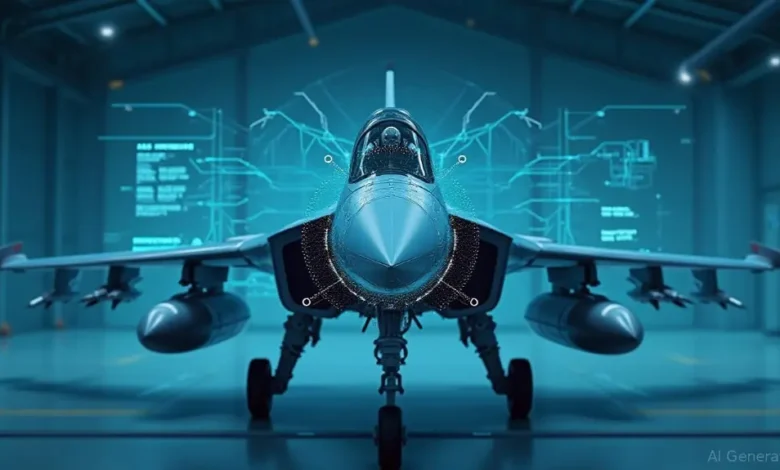The Rise of AI in Military Aviation

Smarter Skies, Faster Decisions
Artificial Intelligence (AI) is no longer science fiction—it’s reshaping military aviation in real time. From pilotless fighters to AI co-pilots, intelligent systems are accelerating decision-making, reducing human error, and redefining air combat.
In modern conflicts, AI already guides drones, detects threats, and plans missions. Soon, it could be flying alongside or even replacing pilots in high-risk missions.
This article explores how AI is transforming military aviation, the technologies leading the change, and what it means for the future of warfare.
What Is AI in Military Aviation?
AI in military aviation refers to software systems that learn, adapt, and make decisions in flight operations—without constant human input.
Unlike simple automation, AI can:
- Analyze sensor data in real time
- Predict enemy movements
- Adjust flight paths under threat
- Control multiple drones at once
These systems are trained on vast datasets of flight patterns, radar signals, and combat scenarios—enabling them to act faster than any human.
Key fact: The U.S. Air Force tested an AI pilot in 2020 that defeated a human pilot in a simulated dogfight—a turning point in aviation history.
AI in Drones and Unmanned Combat Aircraft
AI is the brain behind modern combat drones.
- Autonomous surveillance: AI analyzes video feeds to detect tanks, troops, or missile launches.
- Target recognition: Machine learning identifies enemy vehicles with over 90% accuracy.
- Loitering munitions: AI-powered drones like the Switchblade 600 can hunt and strike targets on their own.
More advanced systems, like the Kratos XQ-58A Valkyrie, are designed as AI-driven loyal wingmen—flying ahead of fighter jets to jam radar or launch missiles.
In Ukraine, AI-assisted drones use automated image recognition to locate Russian artillery—cutting response time from hours to minutes.
AI Co-Pilots and Manned Aircraft Support
AI isn’t replacing pilots—yet. But it’s becoming their smartest crew member.
Programs like DARPA’s Air Combat Evolution (ACE) have developed AI “co-pilots” that:
- Manage navigation and communication
- Monitor aircraft systems
- Take control during emergencies
- Simulate combat tactics in real time
In 2023, the U.S. Air Force flew an F-16 with an AI co-pilot (called “Skyborg”) on a 3-hour test flight—proving AI can handle complex missions safely.
Future vision: One pilot could command a swarm of 4–6 AI drones using voice or brainwave interfaces.
Threat Detection and Decision Assistance
Modern battlefields are too fast for human-only decisions. AI steps in by:
- Fusing radar, infrared, and electronic signals into a single battlefield picture
- Warning pilots of incoming missiles or enemy jets
- Recommending evasive maneuvers or countermeasures
The F-35’s sensor fusion system already uses AI-like algorithms to prioritize threats—giving pilots a 360-degree awareness.
AI can assess hundreds of scenarios in seconds—a decisive edge in life-or-death moments.
Autonomous Swarms and Combat Networks
One of AI’s most powerful applications is drone swarming.
- Dozens of small drones coordinate via AI to surround, confuse, and attack enemy defenses.
- They adapt in real time—if one is destroyed, the swarm reorganizes.
- Used for reconnaissance, jamming, or kamikaze strikes.
In 2022, China tested a 10,000-drone swarm—the largest ever. The U.S. and Russia are racing to match this capability.
Game-changer: AI swarms can overwhelm even the most advanced air defenses through numbers, speed, and coordination.
Ethical and Strategic Challenges
AI in combat raises serious concerns:
- Lethal autonomy: Should a machine be allowed to decide to kill without human approval?
- Hacking risks: AI systems could be tricked or hijacked with fake data.
- Escalation danger: Fast AI decisions could trigger unintended conflicts.
- Accountability: Who is responsible if an AI drone kills civilians?
Most nations follow a “human-in-the-loop” rule—requiring human approval for lethal actions. But pressure to go faster may erode this standard.
Global Leaders in Military AI
| Country | Key AI Programs | Notable Projects |
|---|---|---|
| USA | Skyborg, ACE, Valkyrie | AI F-16 flights, loyal wingman drones |
| China | Swarm tech, AI command | 10,000-drone test, stealth UAVs |
| Russia | S-70 Okhotnik | Stealth combat drone with AI control |
| Turkey | Bayraktar AI upgrades | Smart targeting for TB2 drones |
| UK | Mosquito drone | AI-powered stealth UAV project |
The U.S. and China are in a silent arms race for AI air dominance—where software may matter more than hardware.
Conclusion: The Future Is Intelligent
AI is not replacing fighter jets or pilots overnight—but it’s transforming how air power is used.
From smarter drones to AI co-pilots and autonomous swarms, intelligent systems are becoming force multipliers on the battlefield.
The future of military aviation belongs to those who can integrate AI safely, ethically, and effectively—turning data into dominance.
Final thought: The fastest jet won yesterday’s war. The smartest AI will win tomorrow’s.
FAQ
Q: Can AI fly a fighter jet alone?
A: Yes—in tests. The U.S. has flown AI-piloted F-16s, but human approval is still required for combat.
Q: Are AI drones already killing people?
A: Some loitering munitions have “fire-and-forget” modes, but fully autonomous kills remain rare and controversial.
Q: How does AI improve mission success?
A: By processing data faster, reducing pilot workload, and enabling real-time tactical adjustments.
Q: Will AI make pilots obsolete?
A: Not soon. Humans are still needed for ethics, judgment, and complex decision-making—but their role will evolve.
Destacado: “AI won’t replace pilots—it will make them faster, smarter, and more lethal.”



